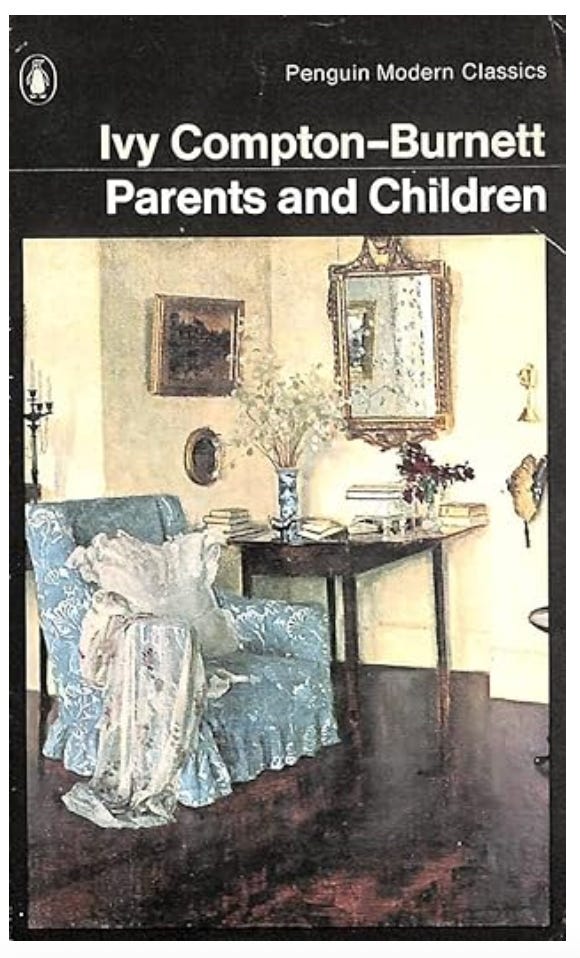Parents and Children (1941) by Ivy Compton-Burnett was recommended to me as the “gateway” into this most mysterious and addictive of authors, since it is comic and, as far as C-B goes, doesn’t contain quite the usual rota of infanticides, suicides and so forth. It also combines elements of romance and even ghost stories. (I read A House and its Head first, purely because it’s one of the only ones in print.)
As is usual, there is a vast family living in a vaster house. Sir Jesse Sullivan and his (unfortunately named) wife Regan brood at the top of the hierarchy. Their son, Fulbert, and his wife Eleanor, have nine children. If I said that large portions of the book concerned Eleanor visiting the children in groups of three, it would suggest that nothing much happened; but the effect is to create an entirely claustrophobic atmosphere, in which Eleanor is seen to be almost utterly powerless, isolated though surrounded by people. Living under her parents-in-law’s thumbs, Eleanor can do little but the daily, repetitive round of visits: stuck in an endless cycle, she longs, like many a C-B character, for escape.
The children are constantly told that, unlike their father and grandfather, who live off the estate, they will have to earn their livings. Although C-B is never specific about times and places, this may be a reflection of the mid-Second World War atmosphere, with many great houses falling into ruin. Despite the air of general decline, there are several staff members. The Sullivans, it seems, could make economies if they wished.
The children range from the intelligent, sarcastic eldest boys, both at Cambridge, Daniel and Graham, whose subtle, malicious insults are a delight, to the youngest, a bright three year old. Where Daniel, as the responsible eldest, works hard, one can only imagine what the effete Graham gets up to. It is one of C-B’s talents that she can suggest all this mostly through dialogue alone.
The children are considered in groups: the almost adults; the ones in between; and the babies. Each child has a distinct personality, with one or two coming to the fore, including the bookish James, who is constantly skiving off school, and the baby, Neville, who refers to himself in the third person. Though education is supposed to be one of the Sullivans’ chief concerns, the children’s tutors are entirely ineffectual: one of them, Miss Milton, does exactly what she wants all the time; another, recently installed, is swiftly verbally overpowered by her charges. Mullett, who is the nurse in charge of Neville and the younger ones, is wonderful: she spins tall stories about her own early life, which, she claims, was one of gentility that fell, reflecting the broader themes of the book.
The Sullivans’ wealth stems partly from business interests in South America, where Sir Jesse spent some time, and Fulbert, as the heir, is sent off to deal with them, causing great upset in the house. Two other families orbit the Sullivans: the Cranmers (two of whose members are called Faith and Hope, and whose eldest son, Ridley, is the Sullivans’ agent); and the Marlowes, who eke out a life of genteel poverty in a cottage at the edge of the estate, a warning of what might happen to the Sullivans. (When it transpires that Graham has got a low third, Sir Jesse suggests he’s going to be a shoe-blacker. Graham takes it in his stride, of course.) The Marlowes spend their time gathering firewood from the park, and worrying about who they might be: they have no idea who their parents were. Their existence is almost Beckettian. Both the Marlowes and the Cranmers have a significance that becomes apparent as revelations occur.
All the C-B novels I’ve read so far have had a central machinator, or Machiavel, and it would be spoiling the plot to say who it is here. But it won’t do that to say that a letter arrives informing the Sullivans that Fulbert is dying. (Letters perform a symbolic function here, acting as vectors of power). And so, with Fulbert gone, the power plays in the house begin to take on a more frantic energy. There are plenty of comic set pieces, such as when Ridley puts on a lion skin to amuse the children, and there is a midly sinister undercurrent too.
As far as patriarchs go, Sir Jesse is a relatively mild one, and Fulbert is beloved by his children and by his wife. Their power, despite Sir Jesse believing in his divine right, is largely illusory, and the children are constantly breaking rules and not really suffering consequences. The family inhabits a state of chaos, yet it’s no wonder that Eleanor decides, fairly quickly, to marry again, and live in a house of her own, visiting the children by day.
The second half of the novel sees the truth exposed. Here the faintly Gothic elements of the novel pick up, as the past collides with the present. Yet there is a “happy” ending, with the Machiavel defeated. It is, however, difficult to believe that anything will actually change the dynamics in the house, and that Eleanor’s fate is to be subsumed: our sympathies are divided.
I’m not sure I would recommend this as the first novel to read for those uninitiated in Compton-Burnett - I think the murder plot in A House and its Head is more easily accessible - but it certainly shows her preoccupations with human nature, and her deep understanding of what confinement does to people. Novices, though, will find much to enjoy in Mullett and her gloomy warnings, as well as in the cutting, quick-moving dialogue.
IN OTHER NEWS
I wrote about the Associated Board of the Royal College of Music stopping giving out certificates for The Spectator.




